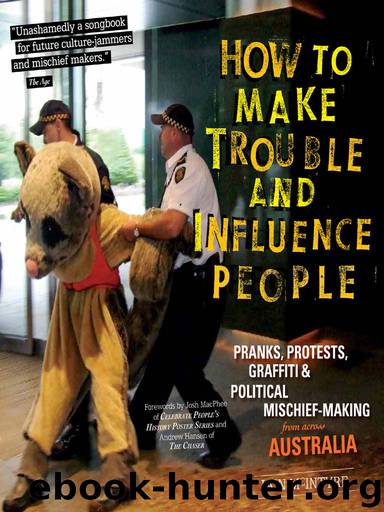How to Make Trouble and Influence People by Iain McIntyre & Andrew Hansen

Author:Iain McIntyre & Andrew Hansen
Language: eng
Format: epub
ISBN: 9781604868807
Publisher: PM Press
MELBOURNE, 1989
Anti-apartheid activists protesting against the presence of South African tennis players at the Australian Open march onto an outer court where one of the sanction-busters is about to play. With the support of a theatre workers’ union, and with police and the Lawn Tennis Association agreeing not to intervene, the demonstrators burn an effigy of South African President Botha.
Reclaim the Streets. Sydney, 1997. Photographer: Ian Sweeney
1990-1999
The neo-liberal reforms and rightward turn in Australian society that had begun during the previous decade gathered pace during the 1990s. New Right think-tanks, backed by corporate largesse, continued to advocate for the destruction of organised labour and the welfare safety net. Battles between the soft-right (known as “wets”) and the hard-right (“dries”) within the Liberal Party saw the latter prevail with new governments in Victoria in 1992 and WA in 1993 legislating anti-union laws and imposing major cuts to social services. Although some major employers had also taken up this fight by engaging in stoushes with unions, most were content to stick with the Accord for the first part of the decade.
And who would blame them? In the context of its continuing embrace of market based solutions, and the abandonment of the idea that government should interfere in the economy to protect the living standards of working class Australians, the ALP at Federal and state levels provided investors with major windfalls. Not only did they speed up the privatisation of publicly owned assets in banking, transport and utilities, and the tendering out of government services, but they also convinced unions to agree to further labour market deregulation. Under the concept of “enterprise bargaining” the ability of the state to control wages and conditions via the arbitration system was watered down and unions agreed to make agreements at a workplace rather than industry level. In the context of a stronger economy and union movement this could have been favourable, and was for a few unions, but with unemployment hitting 10% in 1992 and memberships demobilised it further broke down solidarity and influence. Little surprise therefore that between the acquiescence of the bureaucracy and the further destruction of heavily unionised industries in manufacturing – hitting older, migrant and regional workers hardest – union membership slipped to 31% by 1996.
1991 saw the architect of many of the ALP’s neo-liberal reforms, Treasurer Paul Keating, take over as PM. Before losing power his predecessor Bob Hawke presided over Australia’s first military foray since Vietnam by sending a small force to the Gulf in support of the US invasion of Iraq. Major demonstrations protested this development, spurring on the turn to militancy that a minority in the student, peace and environment movements had already taken. An increase in the level of direct action against logging, the dumping of chemical waste and the importation of rainforest timber was echoed in the membership of all environmental organisations, which topped 700,000 in 1991.
The 1992 culmination of a 10-year court case brought by Torres Strait Islander Eddie Mabo finally saw the High Court recognise that terra nullius had been a myth.
Download
This site does not store any files on its server. We only index and link to content provided by other sites. Please contact the content providers to delete copyright contents if any and email us, we'll remove relevant links or contents immediately.
| Arms Control | Diplomacy |
| Security | Trades & Tariffs |
| Treaties | African |
| Asian | Australian & Oceanian |
| Canadian | Caribbean & Latin American |
| European | Middle Eastern |
| Russian & Former Soviet Union |
The Secret History by Donna Tartt(18845)
The Social Justice Warrior Handbook by Lisa De Pasquale(12141)
Thirteen Reasons Why by Jay Asher(8793)
This Is How You Lose Her by Junot Diaz(6794)
Weapons of Math Destruction by Cathy O'Neil(6143)
Zero to One by Peter Thiel(5685)
Beartown by Fredrik Backman(5596)
The Myth of the Strong Leader by Archie Brown(5425)
The Fire Next Time by James Baldwin(5248)
How Democracies Die by Steven Levitsky & Daniel Ziblatt(5128)
Promise Me, Dad by Joe Biden(5087)
Stone's Rules by Roger Stone(5026)
A Higher Loyalty: Truth, Lies, and Leadership by James Comey(4843)
100 Deadly Skills by Clint Emerson(4840)
Rise and Kill First by Ronen Bergman(4702)
Secrecy World by Jake Bernstein(4644)
The David Icke Guide to the Global Conspiracy (and how to end it) by David Icke(4625)
The Farm by Tom Rob Smith(4435)
The Doomsday Machine by Daniel Ellsberg(4416)
